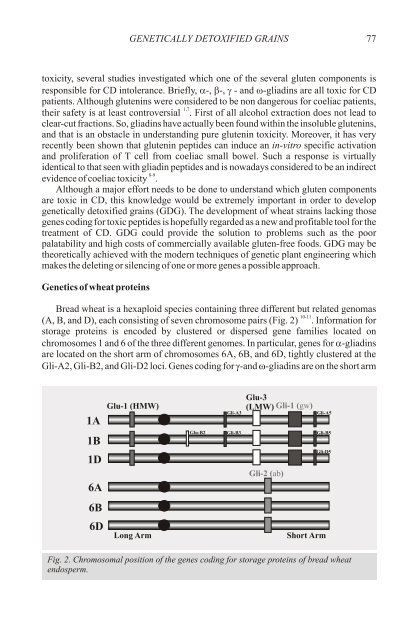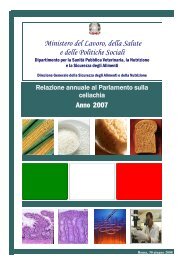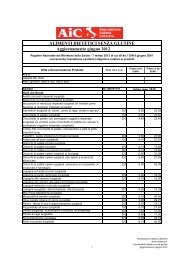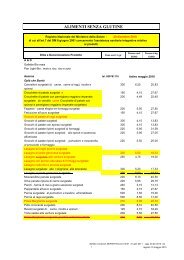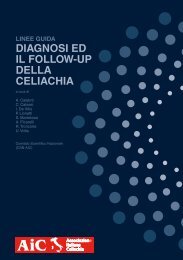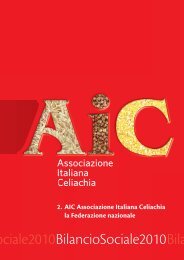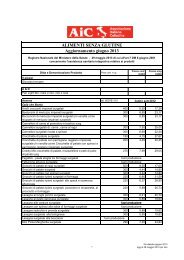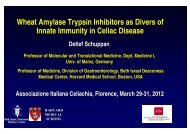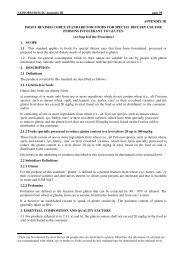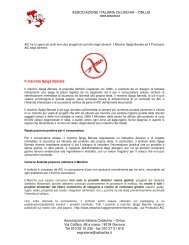primary prevention of coeliac disease - Associazione Italiana ...
primary prevention of coeliac disease - Associazione Italiana ...
primary prevention of coeliac disease - Associazione Italiana ...
Create successful ePaper yourself
Turn your PDF publications into a flip-book with our unique Google optimized e-Paper software.
GENETICALLY DETOXIFIED GRAINS<br />
77<br />
toxicity, several studies investigated which one <strong>of</strong> the several gluten components is<br />
responsible for CD intolerance. Briefly, a-, b-, g- and w-gliadins are all toxic for CD<br />
patients. Although glutenins were considered to be non dangerous for <strong>coeliac</strong> patients,<br />
1,7<br />
their safety is at least controversial . First <strong>of</strong> all alcohol extraction does not lead to<br />
clear-cut fractions. So, gliadins have actually been found within the insoluble glutenins,<br />
and that is an obstacle in understanding pure glutenin toxicity. Moreover, it has very<br />
recently been shown that glutenin peptides can induce an in-vitro specific activation<br />
and proliferation <strong>of</strong> T cell from <strong>coeliac</strong> small bowel. Such a response is virtually<br />
identical to that seen with gliadin peptides and is nowadays considered to be an indirect<br />
8-9<br />
evidence <strong>of</strong> <strong>coeliac</strong> toxicity .<br />
Although a major effort needs to be done to understand which gluten components<br />
are toxic in CD, this knowledge would be extremely important in order to develop<br />
genetically detoxified grains (GDG). The development <strong>of</strong> wheat strains lacking those<br />
genes coding for toxic peptides is hopefully regarded as a new and pr<strong>of</strong>itable tool for the<br />
treatment <strong>of</strong> CD. GDG could provide the solution to problems such as the poor<br />
palatability and high costs <strong>of</strong> commercially available gluten-free foods. GDG may be<br />
theoretically achieved with the modern techniques <strong>of</strong> genetic plant engineering which<br />
makes the deleting or silencing <strong>of</strong> one or more genes a possible approach.<br />
Genetics <strong>of</strong> wheat proteins<br />
Bread wheat is a hexaploid species containing three different but related genomas<br />
10-11<br />
(A, B, and D), each consisting <strong>of</strong> seven chromosome pairs (Fig. 2) . Information for<br />
storage proteins is encoded by clustered or dispersed gene families located on<br />
chromosomes 1 and 6 <strong>of</strong> the three different genomes. In particular, genes for a-gliadins<br />
are located on the short arm <strong>of</strong> chromosomes 6A, 6B, and 6D, tightly clustered at the<br />
Gli-A2, Gli-B2, and Gli-D2 loci. Genes coding for gw<br />
-and -gliadins are on the short arm<br />
1A<br />
1B<br />
1D<br />
6A<br />
Glu-1 (HMW)<br />
Glu-B2<br />
Gli-A3<br />
Gli-B3<br />
Glu-3<br />
(LMW) Gli-1 (gw)<br />
Gli-2 (ab)<br />
Gli-A5<br />
Gli-B5<br />
Gli-D5<br />
6B<br />
6D<br />
Long Arm<br />
Short Arm<br />
Fig. 2. Chromosomal position <strong>of</strong> the genes coding for storage proteins <strong>of</strong> bread wheat<br />
endosperm.


